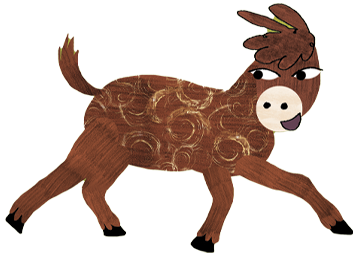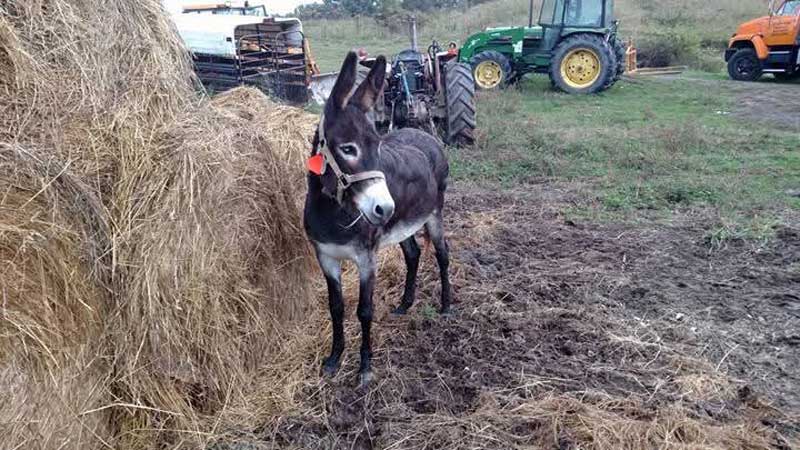
Angel: A Donkey’s Tale
Written and created by Joan Litteral
with Nancy Claxon
Angel:
A Donkey’s Tale
Written and created
by Joan Litteral
with Nancy Claxon
Angel was the luckiest donkey in the world. She lived on a farm near the little village of Oldtown. It was the best place a donkey could live. It had the greenest, tastiest grass to eat, and a little creek that splashed down in the valley gave her plenty of cool water to drink. …
This beautifully illustrated, 8.5″x11″, 40-page, full color hardback children’s book is available for purchase via the Jesse Stuart Foundation in Ashland, Kentucky.

Angel and Hank …
Joan’s Evans Litteral’s daughter Nancy married Phillip Claxon in 1973 and they eventually bought a farm in the Greenup County, Kentucky community of Oldtown, where they raised two daughters, tobacco, and cattle. A combination of chance events and circumstances surrounding their farm lit the spark that led to A Donkey’s Tale.
On Claxon Farm in Oldtown, Kentucky there are cattle, and many calves run the hills and bottoms near the book’s “zigzag fencing” and “Big Red Barn.” A bull, several dogs, sundry cats, wild turkeys, frogs, deer, coyotes and a host of other animals live there. It is a real working farm, and like many farmers in the area, the Claxons turned to a natural remedy to help ease pressure on their calves from the recent decades’ influx of coyotes. Enter “Hank” – the big, grey donkey, who can chase away coyotes with his pounding hoofs and thunderous bray.
Scaring away coyotes has been Hank’s real job for more than a decade, and he performs it well. He settled in easily and quickly learned how to work the system (by handing his pan back through the fence for more corn, for example). But after a short while it became obvious that Hank was lonely and needed companionship. That’s when a little brown donkey arrived on the scene. Angel was the perfect companion for Hank, and they still graze and patrol the hills together constantly. However, it was quite a while before Nancy Claxon noticed that the donkeys did not “perform” in exactly the same way. Over time she noticed that Hank’s bray was not reciprocated by Angel. Rather, when the little brown donkey tried to join in Hank’s song, only a squeaky whisper emerged.

The real-life Angel donkey.
Thus began a real quest for understanding that ended in multiple dead ends. Nancy’s methodical internet sleuthing eventually paid off, however, and the mysterious nature of Angel’s “problem” was finally revealed and “solved.” Once Nancy shared her findings with her mother, Joan Evans Litteral, the framework for A Donkey’s Tale was born. Using the real donkeys, the real setting, and her great granddaughter Layla Boone Litteral as a model for “The Little Girl,” Joan laid out the book’s plot line with Nancy’s help before crafting this warm and inspiring tale in sparse, gentle prose that evokes both her Appalachian homeland and the simple joys and mysteries of childhood.
While no one can be certain about the accent the Big Fierce Bull spoke to Angel with, nor the exact wording the green frog used when offering her advice, the bulk of this inspirational story is true, and we’re convinced that its positive message (It’s OK Not to Bray!) will serve young and old alike for generations.
About the Author
Phyllis Joan Evans Litteral lives in Northeast Kentucky on a hill near the place where she was born. She spent her formative years in Plum Grove Hollow, Greenup County – one ridge over from Jesse Stuart’s W Hollow in the Appalachian Foothills.
As the twelfth of Bud and Hattie Phelps Evans’ twelve children, Joan is one of the youngest (and one of the last remaining) members of “The Greatest Generation.” Her father left the West Virginia coal fields when the union wars broke out and moved his family to this backcountry land of Hattie’s kin. Here they raised their family with borrowed mules on sharecropper’s pay, New Deal wages, and butter and egg money. Having so little, they hardly noticed The Great Depression. Joan and her siblings, like children nationwide, pulled themselves out of poverty by riding the industrial boom that was born of World War II.
Upon graduating from high school in 1950, Joan immediately married and started a family. But when her children started school, Joan took the opportunity to resume her own education. Spurred by her love of knowledge and the need for more income, she began substitute school teaching and attending classes at the local community college. She eventually worked her way to a full-time teaching position and a Master of Education degree from Morehead State University. “Miss Litteral” went on to serve the Kentucky students she loved for thirty-five years, earning the unofficial title of “best teacher I ever had” from hundreds. After retirement, she continued to teach in her role as a Master Volunteer with the Greenup County Kentucky Extension Office, where she led classes in Appalachian arts like sewing, quilting and basket making.
A lifelong voracious reader, Joan was inspired to write her first children’s book when two donkeys—Hank and Angel—came to live on her daughter Nancy’s hill farm as companions for cattle facing coyote pressure. A Donkey’s Tale is loosely based on a true story involving Nancy, a pair of sweet donkeys, Joan, and her great-grand daughter Layla Boone Litteral. Through A Donkeys Tale, Joan shouts from the ridgetops to children everywhere – “It’s OK to be different. I am here, and I see you. You have value.”
